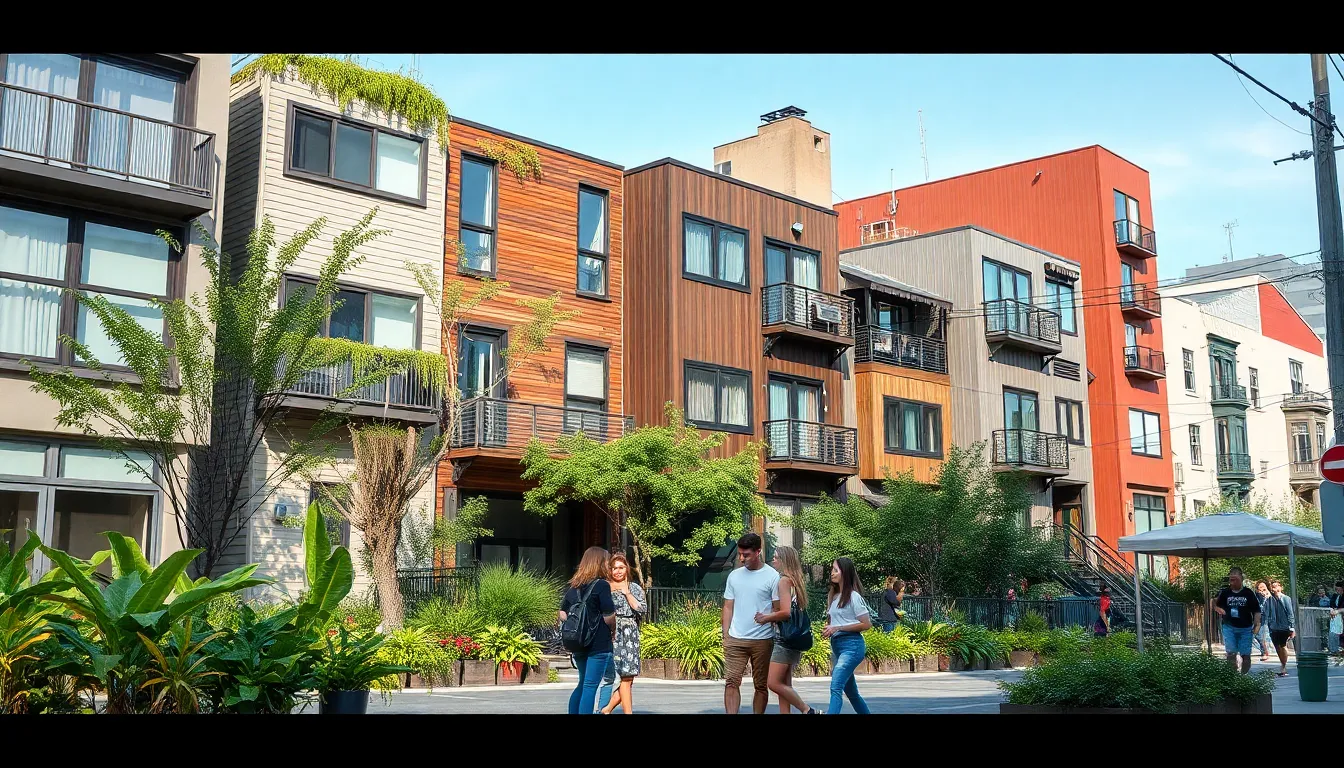Table of Contents
ToggleUrban housing trends are rapidly evolving as cities adapt to the demands of modern living. With increasing populations and shifting lifestyles, innovative solutions are emerging to address housing shortages, affordability, and sustainability. From micro-apartments to co-living spaces, these trends reflect a growing need for flexibility and community in urban environments.
As urban dwellers seek more than just a place to live, developers and architects are reimagining residential spaces to foster connection and enhance quality of life. Smart technology, eco-friendly designs, and mixed-use developments are becoming the norm, reshaping how people interact with their surroundings. Understanding these trends is essential for anyone interested in the future of urban living and the impact it has on communities.
Overview of Urban Housing Trends
Urban housing trends reflect the dynamic nature of city living, shaped by population growth and lifestyle shifts. Innovations in residential design, such as micro-apartments, address housing shortages effectively. These compact living spaces meet the needs of singles and young professionals seeking affordability and convenience.
Co-living spaces represent another significant trend, fostering community among residents. This model encourages collaboration and sharing resources, often resulting in lower living costs. Developers focus on creating environments that enhance social interaction, catering to a growing desire for community engagement.
Sustainability remains a priority in urban housing. Eco-friendly designs utilize sustainable materials and incorporate energy-efficient technologies. Green roofs, solar panels, and smart home features improve energy conservation, aligning with modern environmental values.
Mixed-use developments gain popularity, integrating residential, commercial, and recreational spaces. Such designs promote a vibrant urban lifestyle, reducing dependency on cars and encouraging walking or cycling. As cities embrace these trends, the focus shifts towards enhancing quality of life while addressing pressing housing challenges.
Flexibility in design allows for adaptability in urban housing. Developers consider the need for varied living arrangements, accommodating different family structures and lifestyles. This adaptability plays a crucial role in meeting the ever-changing demands of urban populations.
Ultimately, the awareness of these trends becomes essential for stakeholders invested in urban living’s future. They reflect urban environments’ evolving nature and impact on community wellbeing.
Factors Influencing Urban Housing Trends

Several key factors influence the evolution of urban housing trends, shaping how cities adapt to modern challenges and changing demographics.
Economic Factors
Economic conditions significantly impact urban housing. The affordability of housing depends on income levels, employment rates, and the overall economic climate. For instance, rising wages can lead to increased demand for premium housing options, while economic downturns often result in a greater focus on affordable living solutions. Market fluctuations can also affect construction costs and availability of materials, influencing the types of housing that developers pursue. Incentives like tax credits and grants for housing projects further drive innovation in urban housing.
Social Factors
Social dynamics play a critical role in shaping urban housing trends. Population growth, shifting demographics, and preferences for community living directly influence housing styles and availability. Younger generations often seek flexible living arrangements, which promotes the rise of co-living spaces and shared resources. Additionally, cultural shifts towards urban lifestyles prioritize accessibility to amenities and public transport, compelling developers to focus on mixed-use spaces. Diversity in family structures, with an increase in single-person households, necessitates varied housing options to meet different needs.
Environmental Factors
Environmental considerations increasingly influence urban housing developments. Growing awareness of climate change and the need for sustainable practices has led to the incorporation of green building designs and eco-friendly technologies. Sustainable materials, energy-efficient systems, and water-saving features are now staples in new constructions. Urban planners are also focusing on creating green spaces within developments to enhance urban ecosystems. Moreover, regulations aimed at reducing carbon footprints shape housing policies, ensuring new projects adhere to sustainability guidelines.
Current Urban Housing Trends
Urban housing continues to evolve as cities adapt to contemporary living demands. Current trends demonstrate a strong emphasis on sustainability, technological advancements, and community-oriented designs.
Sustainable Housing Solutions
Sustainable housing solutions focus on eco-friendly practices that reduce environmental impact. Buildings utilize sustainable materials, such as bamboo and recycled steel, which lower carbon footprints. Energy-efficient technologies, like solar panels and smart thermostats, enhance energy conservation. Green roofs and living walls improve air quality and biodiversity in urban settings. Water conservation systems, including rainwater harvesting and greywater recycling, further promote responsible resource usage. Developers increasingly prioritize mixed-use developments that integrate residential areas with commercial and recreational spaces, fostering a vibrant and accessible urban lifestyle.
Smart Housing Technology
Smart housing technology transforms urban living by integrating advanced tech solutions. Homes equipped with smart devices, such as automated lighting and security systems, enhance convenience and safety. Internet of Things (IoT) applications allow residents to monitor energy usage and optimize heating and cooling systems for improved efficiency. Smart home integrations enable remote management of appliances and security features via mobile devices. Data analytics tools provide insights into energy consumption patterns, helping residents reduce costs and environmental impact. As urban housing continues to modernize, the adoption of smart technologies creates intuitive, efficient living environments while enhancing the overall resident experience.
Challenges in Urban Housing
Urban housing faces significant challenges that impact residents and city planners alike. Affordability and space limitations dominate the discussion surrounding effective solutions to housing needs.
Affordability Issues
Affordability remains a primary concern in urban housing development. Cities often experience soaring housing costs due to high demand, limited supply, and increasing property values. The Urban Institute reports that nearly 30% of households spend more than 30% of their income on housing, which classifies them as cost-burdened. Low-income families struggle to find affordable options, while young professionals and newcomers frequently face steep rents. Consequently, innovative measures, such as inclusionary zoning and rent control, may emerge to ensure that a portion of new developments remains accessible to those with lower income levels.
Space Limitations
Space limitations in urban areas complicate housing solutions significantly. As populations grow, the demand for housing exceeds available land, leading to overcrowding and inadequate living conditions. A study by the National Multifamily Housing Council indicates that urban centers need to construct approximately 4.6 million new apartments by 2030 to meet housing demands. Vertical living solutions, such as high-rise buildings, can maximize limited land space, yet they might not accommodate all family structures. Additionally, zoning regulations often hinder development, limiting construction possibilities in densely populated neighborhoods. As cities strive to create sustainable housing, addressing these spatial constraints becomes increasingly critical.
Future Predictions for Urban Housing
Urban housing is poised for transformation in response to ongoing demands. Growing populations are expected to drive the need for more diverse and efficient living arrangements. Predicted trends include an increase in the popularity of micro-apartments, which will continue catering to singles and young professionals seeking affordable options in urban environments.
Co-living spaces are likely to expand as more individuals prioritize community and collaborative living experiences. These spaces can enhance affordability for residents while fostering strong social networks. Future developments may further integrate technology to promote shared resources and communal activities, supporting a vibrant urban lifestyle.
Sustainability will remain at the forefront of urban housing innovations. Expect eco-friendly designs that utilize renewable materials and energy-saving technologies to dominate new construction projects. The adoption of green roofs and advanced solar panel systems in more buildings will contribute to reduced energy consumption and lower environmental footprints.
Mixed-use developments may see accelerated growth, resulting in neighborhoods that combine residential, commercial, and recreational elements. These spaces facilitate convenient access to amenities, diminishing reliance on personal vehicles and encouraging walkability.
Design flexibility will evolve to address varying family dynamics and lifestyles. Future urban housing solutions may prioritize adaptable spaces that can be transformed for different uses, accommodating shifting needs of residents over time.
Economic pressures will continue to shape urban housing trends. As household incomes fluctuate, innovative policy solutions like inclusionary zoning and rent stabilization will gain importance to maintain housing affordability for lower-income households.
Addressing space limitations is crucial as urban centers face increasing populations. High-density living solutions, including vertical construction, will become essential in maximizing land use while adhering to zoning regulations that may need revision to foster development.
Acknowledging these trends and predictions will benefit stakeholders aiming to enhance urban living conditions and ensure community well-being in the face of evolving urban dynamics.
Urban housing trends are evolving rapidly to meet the demands of modern city living. The focus on sustainability and community-oriented designs is reshaping how people experience urban environments. As cities adapt to increasing populations and changing lifestyles, innovative solutions like micro-apartments and co-living spaces are becoming more prevalent.
The integration of eco-friendly practices and smart technologies is not just a trend but a necessity for future developments. Addressing affordability and space limitations remains crucial for ensuring that urban living is accessible to all. Stakeholders must stay informed about these trends to navigate the complexities of urban housing effectively. The future of urban living holds promise, driven by creativity and a commitment to sustainability.





